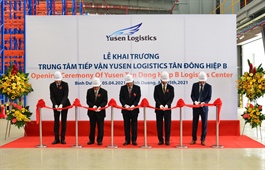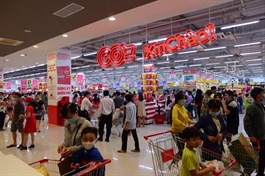What awaits logistics in Vietnam
What awaits logistics in Vietnam
John Campbell, manager of Industrial Services at Savills Vietnam, outlines the major trends facing the logistics industry in the year coming.

John Campbell, manager of Industrial Services at Savills Vietnam
|
Vietnam ranked among world’s top 10 emerging logistics markets
2021 has witnessed a bright start for Vietnam’s logistics sector, which ranked among the world’s top 10 emerging logistics markets in the 2021 Emerging Markets Logistics Index with a score of 5.67 out of 10. It jumped three spots to eighth in this year’s global index of emerging logistics markets after emerging as a popular manufacturing hub, particularly with the recent mass relocation of production out China. The report emphasised Vietnam’s improved performance across domestic logistics opportunities, international logistics opportunities and business fundamentals.
Logistics industry forecast to grow in 2021 on global recovery
According to the Vietnam Logistics Business Association's latest survey, there are around 30,000 logistics companies in the country, 4,000 of them foreign-owned. Furthermore, the industry has been growing at 12-14 per cent annually and is now worth over $40 billion.
According to SSI Securities, the growth prospect of the seaport and logistics industry is positive in 2021, forecasted to grow significantly on the possibility of global trade recovery this year when the COVID-19 vaccine is administered worldwide. The securities company expects the revenue of the seaport and logistics industry would expand by 10 per cent in 2021. The expansion of Cai Mep-Thị Vai and Lach Huyen seaports, for example, would attract big ships to Vietnam instead of Singapore and Hong Kong.
This year will also witness Gemalink Port – Vietnam's largest deep seaport – put into use at least 80 per cent of its designed capacity and reach its full capacity of 1.5 million TEU by 2022. Beginning construction in February 2019, Gemalink is the biggest seaport in the Cai Mep-Thi Vai complex with a total investment of $520 million and becoming one of the world’s 19 largest deep seaports with the capability to receive the world's largest ships (up to 200,000 DWT) today.
Despite being affected by the pandemic last year, the industry was confident about the country’s trade growth thanks to positive impacts of free trade agreements (FTAs) which were signed recently, including the EU-Vietnam FTA (EVFTA) and the Regional Comprehensive Economic Partnership (RCEP). In addition, expectations on investment inflow triggered by the global production shift out of China is another driver instilling confidence in the sector’s recovery.
Statistics from the General Statistics Office showed that Vietnam’s total import-export value reached $543.9 billion in 2020, up 5.1 per cent on-year. It is also predicted by SSI that Vietnam’s import-export value and total goods via seaports would increase by approximately 10 per cent in 2021, pushed by global recovery, FTAs, and the global production shift out of China.
Warehousing demand continues to rise
This expectation was also driving demand for logistics infrastructure. For example, total warehouse area increased significantly in recent years and the price escalated over 5-10 per cent on-year. According to Savills Vietnam figures, the average warehouse rental price in the North and South Economic Zones in 2020 was $4.1 per square metre per month and $4.4 per sq.m per month, respectively.
New warehousing and distribution centre projects are sprawling to Long An and Dong Nai as Ho Chi Minh City and Binh Duong province have restricted supply. In Long An for example, JD.com invested in a new 10-hectare warehouse project in Duc Hoa district and Cianiao Network (Alibaba logistics provider) has a new 15ha project in Ben Luc district. Last year also witnessed the announcement of LOGOS Property entering the market with a $350 million logistics development joint venture. The Australian developer has also invested in its own warehousing project in Can Giouc district, Long An.
Global warehousing costs, Savills Research
According to Savills Global Warehousing Costs report by Paul Tostevin, director of Savills Research, when it comes to analysing total warehousing property costs, aside from rental rates, it is also important to factor in labour costs which are typically the single largest component of a warehousing operation (often making up half of all operational costs). Electricity and diesel costs, for the running of buildings and their vehicle fleets, are also a major factor in warehousing operations. The report stated that very low labour costs coupled with extremely low energy costs make operations in Vietnam the cheapest location of the reports sample (54 markets across 21 countries), led by Hanoi. These low costs make Vietnam highly attractive to multinationals setting up operations in the country, but the government is actively targeting higher value companies. Troy Griffiths, deputy managing director of Savills Vietnam, said, “The government has been investing heavily in all manner of infrastructure while promoting industrial clusters to attract businesses higher up the value chain. High levels of corporate taxation relief are also available to ensure healthy regional competition.”
Suez blockage threatens Vietnam trade
The Suez Canal blockage caused by the Taiwanese container vessel Ever Given is threatening to delay some of Vietnam’s exports and imports with Europe and the US, leaving exporters concerned. As the situation continues, Vietnamese seafood exporters will suffer as they have to ship seafood to their partners, according to Truong Dinh Hoe, general secretary of the Vietnam Association of Seafood Exporters and Producers (VASEP).
The Ministry of Industry and Trade has advised exporters to adopt the necessary measures to limit any economic damage posed by the situation. For example, the Vietnamese Trade Office in Egypt recommended Vietnamese firms to coordinate closely with shipping companies for updates on the transport capacity, time of docking, and goods loading.
It was also advised to take out insurance against delays or possible damage of goods, especially aquatic products. Businesses would also need to contact the Vietnam Trade Office and work with importers to address possible problems related to slow delivery to avoid any trade disputes.























